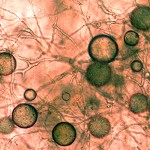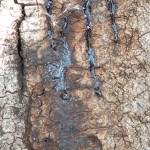SOD Blitz Results 2014 – Press Release
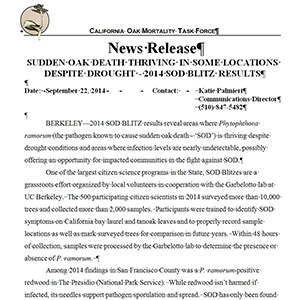
matteolab.org


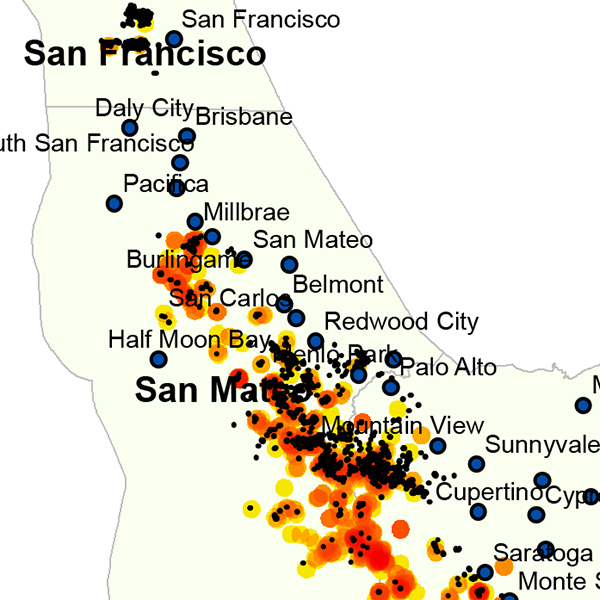
Sudden Oak Death can kill oak and tanoak trees but it vectored, or spread, primarily through the leaves of California bay laurel. You can see what SOD symptoms on bay leaves look like in this picture. In the spring of each year the lab hosts the SOD Blitz Survey Project where you can learn to spot SOD infections, collect leaves on your trees, and have them tested for SOD.
Yes! There are free meetings and workshops that you can participate in throughout the year:
You may also want to check out the SOD Blitz project webpage for more information.
Our lab does not provide a year-round SOD testing service. However, each spring we conduct the SOD Blitz Survey Project that trains “citizen-scientists” to collect leaf samples in their communities and provides free testing in our laboratory. You might also be interested in seeing how we test for SOD.
There are a number of things to keep in mind regarding SOD disease management, you might want to check out these two guides: What to do before SOD arrives in your area and What to do after SOD arrives. There are also preventative chemical treatments available and SOD treatment training workshops conducted at UC Berkeley.
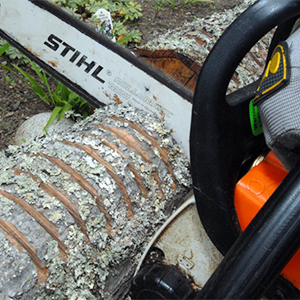
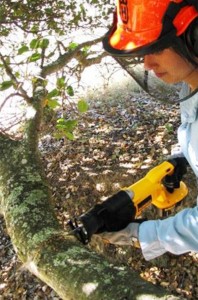
Cleaning tools in SOD-infested areas.
Can tools become infectious when used on trees infected by SOD? Yes, in particular when dealing with infected foliage, infested soil, and marginally with infected wood. The risk of spreading SOD is higher if soil or infected leaves are present on tires, shoes or tools. Wood is generally, not as infectious
Differently from other pathogens which produce invisible microscopic and often sticky spores that can remain viable even on apparently clean tools, the SOD pathogen produces spores that are normally lodged in plant debris, organic matter, and plant or soil residue.
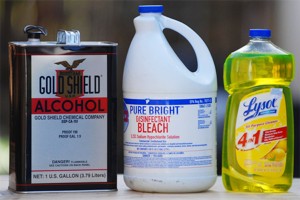
Note: it is important to ensure all parts that came in contact with infected plant material are visibly clean and that no organic matter remains. This is particularly crucial for tools like chainsaws or machinery like chippers. The physical cleaning step (above) is critical, and can be effective even without washing although the application of a disinfectant may help). Washing first and then cleaning will be ineffective. Always wear safety glasses and protective equipment as recommended by the manufacturer and always follow the manufacturer’s directions, restrictions, and precautions on the product label.
To test the effectiveness of tool cleaning on the transmission of P. ramorum, a chainsaw and handsaws were “contaminated” with SOD-infected wood chips and saw dust. The saws were treated by different methods in an attempt to “decontaminate” them including, removing the visible organic matter with a wire brush or brushing followed by a disinfectant rinse. The disinfectants used were 10% ethanol, 5% bleach, and lysol (diluted as instructed on the label).
After cleaning, the saws were examined under magnification, any remaining bits of plant or organic matter plated on selective agar Petri dishes. The percentage of infectious propagules that grew on the agar plates is graphed below. Click to rebigulate the pdf.
Disclaimer: Mention of any company, trade name, or commercial product does not constitute endorsement by the University of California or recommendation for use. Always follow the manufacturer’s directions, restrictions, and precautions on the product label.
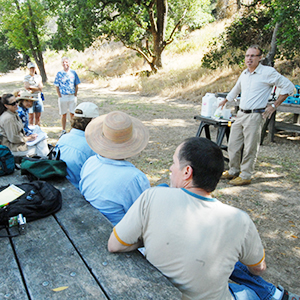
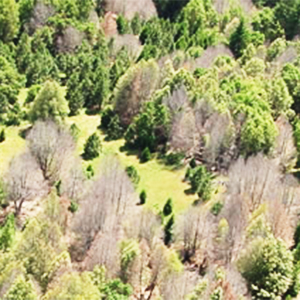
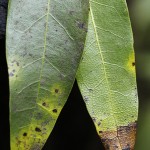 SOD is an exotic disease caused by the microscopic pathogen Phytophthora ramorum, estimated to have been introduced into California 20-25 years ago from unknown region of the world.
SOD is an exotic disease caused by the microscopic pathogen Phytophthora ramorum, estimated to have been introduced into California 20-25 years ago from unknown region of the world.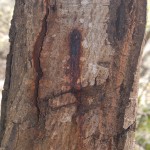 and a foliar infection. Tanoaks are the only tree species that can spread the the disease and die from it as well. When P. ramorum infects oaks and tanoaks it destroys the cambium under the bark and effectively girdles the tree. Girdled trees are doomed, but can survive for 1 to 5+ years thanks to stored resources and their natural tolerance to drought.
and a foliar infection. Tanoaks are the only tree species that can spread the the disease and die from it as well. When P. ramorum infects oaks and tanoaks it destroys the cambium under the bark and effectively girdles the tree. Girdled trees are doomed, but can survive for 1 to 5+ years thanks to stored resources and their natural tolerance to drought.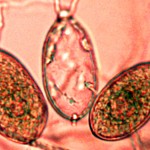 percipitation.
percipitation.